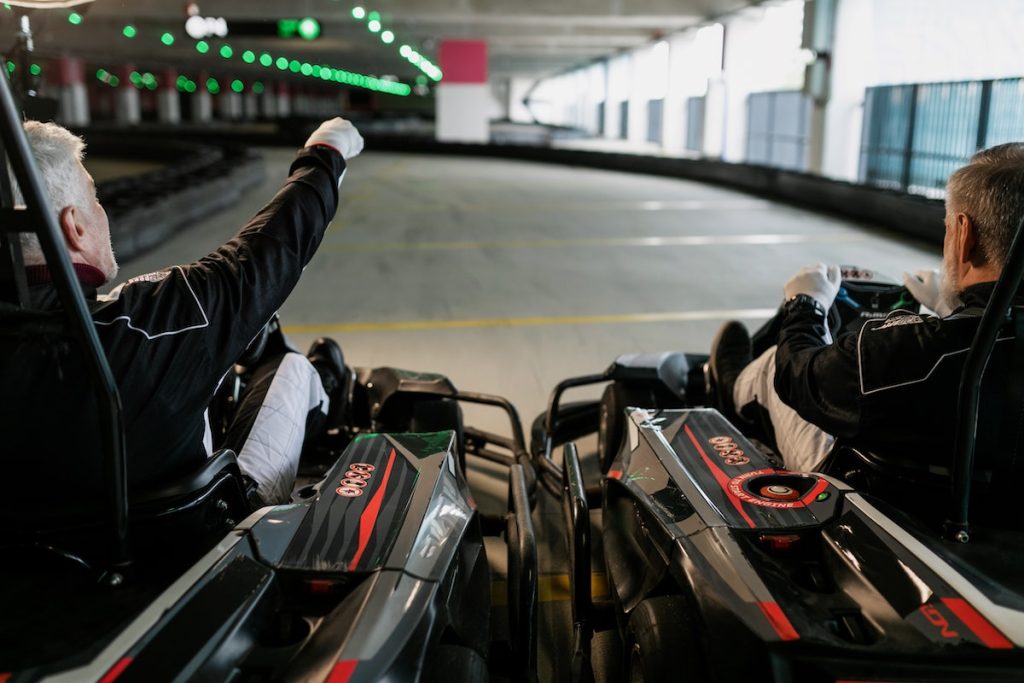Motorsports have captivated audiences worldwide with their exhilarating races and high-speed action. Among them, Formula One stands as a pinnacle, boasting a staggering viewership of 455 million in 2021 alone. As enthusiasts and fans discuss the races, one topic that often takes center stage is the incredible speeds attained by Formula 1 cars.
The quest to understand just how fast Formula 1 cars go has become a fascination, as it offers a glimpse into the unparalleled performance and engineering mastery that fuels this electrifying sport.

What makes Formula 1 cars unique?
Formula 1 cars are unparalleled in their uniqueness, combining cutting-edge technology, engineering precision, and aerodynamic mastery. These racing machines are meticulously designed to optimize speed and performance, featuring lightweight carbon fiber construction, advanced suspension systems, and powerful hybrid engines. Their aerodynamic profiles, with intricate wings and diffusers, generate immense downforce, enabling them to navigate corners at mind-boggling speeds.
How does speed play a crucial role in Formula 1 racing?
Speed is the lifeblood of Formula 1 racing. It defines the essence of the sport, pushing the limits of human and machine capabilities. How fast Formula 1 cars go determines the outcome of races, as drivers strive to achieve blistering lap times and overtake opponents with split-second precision, showcasing the sheer adrenaline and excitement that defines this high-octane motorsport.
How fast can Formula 1 cars go?
When it comes to raw speed, Formula 1 cars are at the forefront of motorsport. Pushing the boundaries of velocity, these cutting-edge machines captivate fans worldwide with their incredible acceleration and mind-boggling top speeds.
What is the top speed of a Formula 1 car?
The top speed of an F1 car can vary depending on multiple factors, such as the track layout, aerodynamic setup, and engine power. These lightning-fast machines generally reach astonishing speeds of over 230 mph (370 km/h). However, it’s important to note that achieving these top speeds is usually limited to long straights during races, where the cars can unleash their full power and maximize their velocity.

Comparing Formula 1 Cars to other Racing Cars
When it comes to speed, various racing categories have their impressive capabilities. Here’s how Formula 1 cars compare to other racing giants in terms of maximum speeds.
IndyCar
IndyCars, renowned for their blistering pace, can achieve top speeds of around 240 mph (386 km/h). These open-wheel machines generate immense speed on oval tracks, captivating fans with their high-octane battles.
MotoGP
MotoGP motorcycles, purpose-built for precision and agility, can reach remarkable speeds of approximately 220 mph (354 km/h). These two-wheeled beasts showcase extraordinary acceleration and maneuverability, thrilling spectators with their close-quarter battles.
NASCAR
NASCAR, famous for its intense oval track racing, sees its stock cars hit top speeds of about 200 mph (322 km/h). These powerful machines rely on drafting and strategic positioning to maintain speed and execute daring overtakes.
Formula 2
Formula 2 cars, a stepping stone to Formula 1, possess considerable speed, typically reaching top speeds of around 200 mph (322 km/h). These single-seaters showcase impressive aerodynamics and engine power, setting the stage for young talent to shine.
Formula 3
Formula 3 cars, nurturing the future stars of motorsport, achieve top speeds of approximately 180 mph (290 km/h). These lightweight, nimble machines exhibit remarkable handling and cornering capabilities, providing a thrilling platform for aspiring racers.
Formula E
Formula E, the all-electric racing series, showcases sustainable speed with its cars achieving top speeds of around 174 mph (280 km/h). These electric-powered machines combine cutting-edge technology with close and intense city street racing, emphasizing sustainability in the world of motorsports.

How fast can Formula 1 Cars accelerate?
Formula 1 cars are renowned for their lightning-fast acceleration, showcasing their immense power and engineering prowess. These high-performance machines can accelerate from 0 to 60 mph (0 to 97 km/h) in a mind-boggling time of around 2 seconds. In just a matter of seconds, Formula 1 cars can catapult themselves to incredible speeds, emphasizing their ability to generate immense traction, harnessing every ounce of power to propel the driver forward with breathtaking velocity.
Fastest Formula 1 Cars in History
Which Formula 1 cars hold the record for top speed?
The record for the highest top speed in a Formula 1 car is held by Honda with their RA106. In an attempt to break the 400 km/h barrier, Honda took the car to the Bonneville Salt Flats in the US, renowned for top-speed runs. While they fell short of their goal, they achieved an impressive top speed of 397.36 km/h (246.9 mph) – the highest recorded speed in an F1 car.
Legendary drivers and their incredible speed achievements
Throughout Formula 1 history, legendary drivers have showcased remarkable speed achievements. Drivers like Michael Schumacher, Ayrton Senna, and Lewis Hamilton have consistently pushed the limits, setting numerous records for pole positions, fastest laps, and race victories. Their exceptional skills and fearless determination have allowed them to achieve incredible speeds, leaving an indelible mark on the sport and etching their names into the annals of racing history.
Technology and Engineering Behind Formula 1 Cars
The technology and engineering behind Formula 1 cars are a testament to human innovation and precision. These cutting-edge machines employ advanced aerodynamics, lightweight materials like carbon fiber, and powerful hybrid engines. The intricate suspension systems, advanced electronics, and tire technology work harmoniously to optimize grip, handling, and speed.
Ensuring safety at high speeds
Safety considerations and regulations to control speed
Ensuring safety at high speeds in Formula 1 is of paramount importance. Stringent regulations and safety considerations are implemented to control speed, including track design, safety barriers, tire regulations, and limits on engine power and fuel usage. These measures aim to strike a balance between thrilling speed and the protection of drivers and spectators.
Innovations in safety technology for driver protection
In response to the inherent risks of high-speed racing, Formula 1 has seen remarkable advancements in safety technology. Innovations such as the Halo device, energy-absorbing crash structures, improved helmet designs, and enhanced cockpit protection systems have been introduced to provide comprehensive driver protection. These safety measures continuously evolve to minimize the risks associated with the incredible speeds achieved in Formula 1.
Other Trivias about F1 Cars and Racing
Formula 1 cars and racing are filled with intriguing trivia that add to the allure of the sport. Here are some interesting tidbits:
- Tyre Changes: Until the 2010 season, teams were allowed to change tyres during the race without any restrictions. However, since then, regulations have limited tyre changes to enhance strategy and challenge teams to manage their tyres efficiently.
- Fastest Pit Stops: Pit stops are a critical aspect of Formula 1 races. In recent years, pit crews have achieved mind-boggling speeds, with some pit stops completed in under two seconds. These lightning-fast stops involve changing all four tyres, making adjustments, and refueling the car, showcasing the precision and teamwork of the pit crew.
- Record-Breaking Constructors: Ferrari holds the record for the most constructors’ championships, with a remarkable total of 16 championships to their name. Their legacy and success in Formula 1 have made them an iconic team in the sport.
- Changing Track Lengths: Formula 1 tracks can vary significantly in length. The shortest track on the calendar is the Circuit de Monaco, measuring just 3.34 km (2.07 miles), while the longest track is the Circuit de Spa-Francorchamps in Belgium, stretching 7.00 km (4.35 miles). The diverse track lengths present unique challenges to drivers and teams.
Formula 1 is a thrilling sport that combines speed, technology, and skill in an unparalleled manner. From the mind-bending speeds reached by these incredible machines to the constant pursuit of engineering innovation, Formula 1 captivates audiences worldwide. It stands as a testament to human ingenuity, pushing the boundaries of what is possible in the realm of motorsport.
Frequently Asked Questions
Are Formula 1 cars the fastest cars?
Yes, Formula 1 cars are among the fastest cars in the world, reaching speeds over 230 mph (370 km/h) and boasting incredible acceleration, advanced aerodynamics, and cutting-edge technology.
How do Formula 1 cars go so fast?
Formula 1 cars achieve incredible speeds through a combination of factors and constant technological advancements that optimize performance and maximize speed on the track.
How much does an F1 car cost?
The cost of a Formula 1 car can vary, but estimates suggest that teams spend around $10-20 million per car. This includes research, development, manufacturing, and the use of advanced materials and technologies.
Are F1 cars manual?
No, Formula 1 cars are not manual. They utilize a semi-automatic gearbox with paddle shifters mounted on the steering wheel. The drivers can change gears by pulling or pushing these paddles, allowing for quick and seamless gear changes.
Is F1 a luxury sport?
While Formula 1 is associated with luxury due to its glamorous image and high financial investments, it is primarily a competitive motorsport. It involves technology and engineering excellence and showcases the pinnacle of performance and skill.

